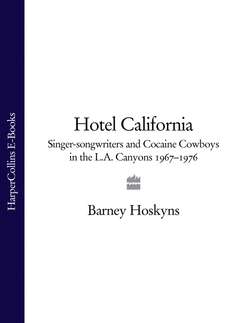Читать книгу Hotel California: Singer-songwriters and Cocaine Cowboys in the L.A. Canyons 1967–1976 - Barney Hoskyns - Страница 13
III: Young Girls Are Coming to the Canyon
ОглавлениеFor Jackson Browne if not for everyone, Paxton proved a sobering experience. On a micro-level it suggested there were limits to how far you could really ‘let it all hang out’. ‘My stopping smoking dope had a lot to do with my becoming serious as a musician,’ Browne reflected later. ‘After two or three years of walking barefoot around Laurel Canyon and sleeping in people’s living rooms and smoking the best dope on the planet…I had this huge self-conscious flash.’
For Judy James, Laurel Canyon became as much a sanctuary as a creative seedbed. It was as though California’s flower children had flown too close to the sun: victims of LSD were already being identified within the culture. ‘You cannot discount the incredible effect that drugs had,’ Judy says. ‘Holy moly! All these people who were so young they weren’t yet formed, who did or didn’t have talent, who did or didn’t believe they were geniuses, who were or were not conmen. And it was all wrapped up in one big thing.’ Early 1968 was about retrenching, putting down roots to counter the lysergic disorientation – not to mention the general political unrest in America. ‘Slowly but surely,’ says Judy, ‘people poured into the canyon. Bill Brogan at the Country Store supported us all in our hard times. He’d been there twenty years already when I moved to the canyon.’
Still holding court in the canyon were ‘Butchie’ Cho, Lotus Wein-stock and Tim Hardin, along with a new group called International Submarine Band, who lived on Ridpath Drive and revolved around a lanky trust-fund kid named Ingram ‘Gram’ Parsons. ‘Laurel Canyon just seemed to be the place,’ says former Bob Dylan sideman Bruce Langhorne, who moved into a house on Lookout Mountain Avenue in 1968. ‘The winters really drove people out of New York.’
Still in the canyon, too, were the Mamas and the Papas, whose John Phillips captured the essence of the place in his song ‘12.30 (Young Girls Are Coming to the Canyon)’. ‘John began that song in New York,’ says fellow Papa Denny Doherty, ‘but he didn’t know what to do with it. When we moved out here, the canyon fit the bill perfectly. Everybody was up there, and all the young girls were looking for all the rock stars. They’d wander the hills calling out names. “We have a cake for you, Denny!!” You’d hide and peek out the windows hoping they didn’t see you.’ But it was Cass Elliott, now living in Natalie Wood’s old house on Woodrow Wilson Drive, who best defined the canyon’s spirit. ‘Cass was Elsa Maxwell meets Sophie Tucker,’ says Doherty. ‘She was a big broad who knew what she looked like to others, and there was no façade. It was “Hi there, come on in, let’s get right to real”.’
‘Cass was a major catalyst,’ says Henry Diltz. ‘You could drop in at her place any time. She wanted to feed everybody. She would always meet these English lads on a TV show and she’d bring them back to the house because they didn’t know anybody in town.’ Attracting what John Phillips later characterised as ‘a band of stoned hippie worshippers’, Cass kept permanent open house – even after giving birth to her daughter Owen. ‘I don’t have the psychology of the fat person,’ Elliott told Richard Goldstein, who described her as ‘Tinkerbelle, sprinkling magic dust over a grooving generation’. But deep down Cass was unhappy. In the company of David Crosby – footloose and fancy-free after his ejection from the Byrds – she pursued her love of opiates, including heroin. ‘There were a couple of good-looking guys that were schtupping Cass,’ says Denny Bruce. ‘They were basically there for her drugs. She got her little taste of cock and they got their dope.’
In any case, all was not well in the Mamas and Papas’ world. The group had closed out the Monterey Pop Festival but were now in disarray. Not for nothing did they release a greatest hits collection entitled Farewell to the First Golden Era. ‘They were under a tremendous amount of pressure,’ says John York, who played bass at the group’s final show in 1968. ‘They’d gone from being great friends to tolerating each other. There were moments where there was camaraderie, but they also maintained their own camps.’
‘By this time we were all burned out completely,’ admits Lou Adler. ‘We were on such a high for those three or four years. Everything we touched turned to gold, and the lifestyle was incredible. We were so high there was no place to go.’ John Phillips was exhibiting early signs of the ravenous arrogance that would eventually destroy his life. Intoxicated by success, he and Michelle moved out of Laurel Canyon and into the late Jeanette MacDonald’s mock-Tudor mansion on Bel Air Road, cramming the place with Lalique crystal, Limoges china, and other required appurtenances of celebrity living. ‘The public relates very strongly to the music and to the lifestyle,’ Phillips announced. ‘It’s all one thing. There’s an aristocracy of lifestyle. It’s a pop star’s life that counts; that’s what involves you, not his performance.’
‘America always recreates an aristocracy, usually drawing on sports, politics, the arts and show business,’ wrote Carl Gottlieb. ‘The new princes and princesses of rock ’n’ roll lost no time in exploring a way of life that had led Old World nobility to ruin and revolution.’
